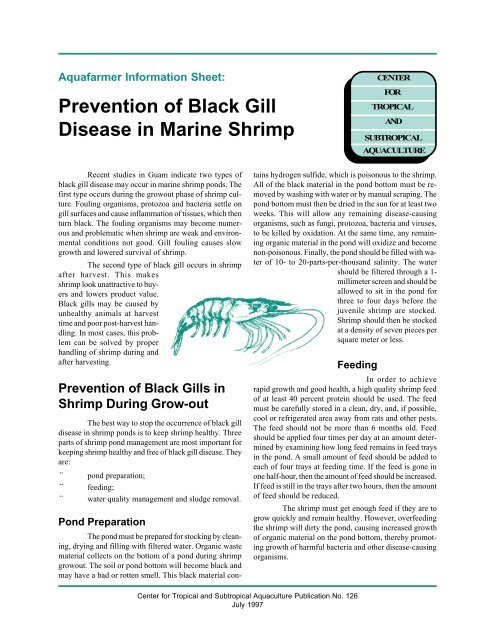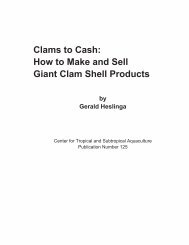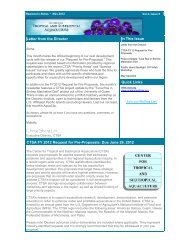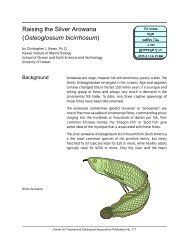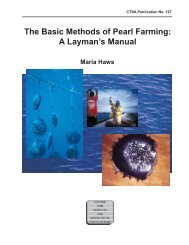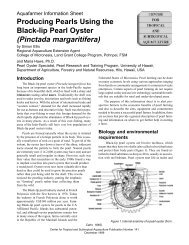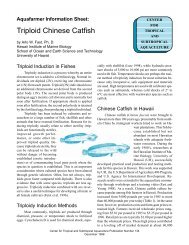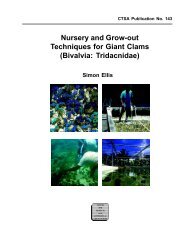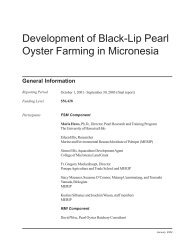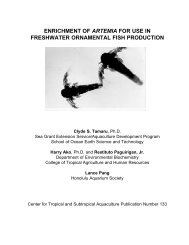Prevention of Black Gill Disease in Marine Shrimp - CTSA
Prevention of Black Gill Disease in Marine Shrimp - CTSA
Prevention of Black Gill Disease in Marine Shrimp - CTSA
Create successful ePaper yourself
Turn your PDF publications into a flip-book with our unique Google optimized e-Paper software.
Aquafarmer Information Sheet:<br />
<strong>Prevention</strong> <strong>of</strong> <strong>Black</strong> <strong>Gill</strong><br />
<strong>Disease</strong> <strong>in</strong> Mar<strong>in</strong>e <strong>Shrimp</strong><br />
CENTER<br />
FOR<br />
TROPICAL<br />
AND<br />
SUBTROPICAL<br />
AQUACULTURE<br />
Recent studies <strong>in</strong> Guam <strong>in</strong>dicate two types <strong>of</strong><br />
black gill disease may occur <strong>in</strong> mar<strong>in</strong>e shrimp ponds. The<br />
first type occurs dur<strong>in</strong>g the growout phase <strong>of</strong> shrimp culture.<br />
Foul<strong>in</strong>g organisms, protozoa and bacteria settle on<br />
gill surfaces and cause <strong>in</strong>flammation <strong>of</strong> tissues, which then<br />
turn black. The foul<strong>in</strong>g organisms may become numerous<br />
and problematic when shrimp are weak and environmental<br />
conditions not good. <strong>Gill</strong> foul<strong>in</strong>g causes slow<br />
growth and lowered survival <strong>of</strong> shrimp.<br />
The second type <strong>of</strong> black gill occurs <strong>in</strong> shrimp<br />
after harvest. This makes<br />
shrimp look unattractive to buyers<br />
and lowers product value.<br />
<strong>Black</strong> gills may be caused by<br />
unhealthy animals at harvest<br />
time and poor post-harvest handl<strong>in</strong>g.<br />
In most cases, this problem<br />
can be solved by proper<br />
handl<strong>in</strong>g <strong>of</strong> shrimp dur<strong>in</strong>g and<br />
after harvest<strong>in</strong>g.<br />
<strong>Prevention</strong> <strong>of</strong> <strong>Black</strong> <strong>Gill</strong>s <strong>in</strong><br />
<strong>Shrimp</strong> Dur<strong>in</strong>g Grow-out<br />
The best way to stop the occurrence <strong>of</strong> black gill<br />
disease <strong>in</strong> shrimp ponds is to keep shrimp healthy. Three<br />
parts <strong>of</strong> shrimp pond management are most important for<br />
keep<strong>in</strong>g shrimp healthy and free <strong>of</strong> black gill disease. They<br />
are:<br />
¨ pond preparation;<br />
¨ feed<strong>in</strong>g;<br />
¨ water quality management and sludge removal.<br />
Pond Preparation<br />
The pond must be prepared for stock<strong>in</strong>g by clean<strong>in</strong>g,<br />
dry<strong>in</strong>g and fill<strong>in</strong>g with filtered water. Organic waste<br />
material collects on the bottom <strong>of</strong> a pond dur<strong>in</strong>g shrimp<br />
growout. The soil or pond bottom will become black and<br />
may have a bad or rotten smell. This black material conta<strong>in</strong>s<br />
hydrogen sulfide, which is poisonous to the shrimp.<br />
All <strong>of</strong> the black material <strong>in</strong> the pond bottom must be removed<br />
by wash<strong>in</strong>g with water or by manual scrap<strong>in</strong>g. The<br />
pond bottom must then be dried <strong>in</strong> the sun for at least two<br />
weeks. This will allow any rema<strong>in</strong><strong>in</strong>g disease-caus<strong>in</strong>g<br />
organisms, such as fungi, protozoa, bacteria and viruses,<br />
to be killed by oxidation. At the same time, any rema<strong>in</strong><strong>in</strong>g<br />
organic material <strong>in</strong> the pond will oxidize and become<br />
non-poisonous. F<strong>in</strong>ally, the pond should be filled with water<br />
<strong>of</strong> 10- to 20-parts-per-thousand sal<strong>in</strong>ity. The water<br />
should be filtered through a 1-<br />
millimeter screen and should be<br />
allowed to sit <strong>in</strong> the pond for<br />
three to four days before the<br />
juvenile shrimp are stocked.<br />
<strong>Shrimp</strong> should then be stocked<br />
at a density <strong>of</strong> seven pieces per<br />
square meter or less.<br />
Feed<strong>in</strong>g<br />
In order to achieve<br />
rapid growth and good health, a high quality shrimp feed<br />
<strong>of</strong> at least 40 percent prote<strong>in</strong> should be used. The feed<br />
must be carefully stored <strong>in</strong> a clean, dry, and, if possible,<br />
cool or refrigerated area away from rats and other pests.<br />
The feed should not be more than 6 months old. Feed<br />
should be applied four times per day at an amount determ<strong>in</strong>ed<br />
by exam<strong>in</strong><strong>in</strong>g how long feed rema<strong>in</strong>s <strong>in</strong> feed trays<br />
<strong>in</strong> the pond. A small amount <strong>of</strong> feed should be added to<br />
each <strong>of</strong> four trays at feed<strong>in</strong>g time. If the feed is gone <strong>in</strong><br />
one half-hour, then the amount <strong>of</strong> feed should be <strong>in</strong>creased.<br />
If feed is still <strong>in</strong> the trays after two hours, then the amount<br />
<strong>of</strong> feed should be reduced.<br />
The shrimp must get enough feed if they are to<br />
grow quickly and rema<strong>in</strong> healthy. However, overfeed<strong>in</strong>g<br />
the shrimp will dirty the pond, caus<strong>in</strong>g <strong>in</strong>creased growth<br />
<strong>of</strong> organic material on the pond bottom, thereby promot<strong>in</strong>g<br />
growth <strong>of</strong> harmful bacteria and other disease-caus<strong>in</strong>g<br />
organisms.<br />
Center for Tropical and Subtropical Aquaculture Publication No. 126<br />
July 1997
Page 2<br />
Water Quality Management and<br />
Sludge Removal<br />
Regular water exchange is needed to keep a pond<br />
clean. The water exchange rate should be about 5 percent<br />
per day dur<strong>in</strong>g the first two months <strong>of</strong> shrimp growout,<br />
10 percent per day dur<strong>in</strong>g the third month <strong>of</strong> growout,<br />
after which it should be <strong>in</strong>creased to 20 percent per day<br />
until the shrimp are harvested.<br />
If shrimp are stocked at 15<br />
pieces per square meter or<br />
more, then aerators or<br />
paddlewheels (at 2- to 4-horsepower<br />
per acre) should be used<br />
at night beg<strong>in</strong>n<strong>in</strong>g <strong>in</strong> the second<br />
month <strong>of</strong> growout and<br />
cont<strong>in</strong>uously after that until<br />
harvest. The aerators should<br />
aerate the water and be placed<br />
so that the water <strong>in</strong> the pond<br />
will sp<strong>in</strong> or circulate. If the<br />
pond has a central dra<strong>in</strong>, then water should be released<br />
through the center dra<strong>in</strong> for about five m<strong>in</strong>utes every day<br />
beg<strong>in</strong>n<strong>in</strong>g <strong>in</strong> the second month <strong>of</strong> growout.<br />
<strong>Prevention</strong> <strong>of</strong> <strong>Black</strong> <strong>Gill</strong><br />
Development After <strong>Shrimp</strong><br />
Harvest<br />
The most important factor <strong>in</strong> provid<strong>in</strong>g high quality<br />
shrimp to market is post-harvest handl<strong>in</strong>g. The follow<strong>in</strong>g<br />
facets <strong>of</strong> handl<strong>in</strong>g must be addressed:<br />
gentle handl<strong>in</strong>g and fast distribution <strong>of</strong> the shrimp;<br />
adequate ic<strong>in</strong>g <strong>of</strong> the shrimp, unless sold live.<br />
Gentle Handl<strong>in</strong>g and Fast<br />
Distribution<br />
Before beg<strong>in</strong>n<strong>in</strong>g a shrimp harvest, the farmer<br />
must have proper conta<strong>in</strong>ers and adequate quantities <strong>of</strong><br />
clean water for the live tank or adequate quantities <strong>of</strong> ice.<br />
Dur<strong>in</strong>g shrimp harvest by net or by dra<strong>in</strong><strong>in</strong>g the<br />
pond, shrimp must be handled quickly and gently to avoid<br />
damage. The shrimp should be r<strong>in</strong>sed clean and transferred<br />
to the live tank or to an ice bath. The ice bath should consist<br />
<strong>of</strong> 50 percent ice and 50 percent saltwater. <strong>Shrimp</strong><br />
can be kept <strong>in</strong> this ice bath for a m<strong>in</strong>imum <strong>of</strong> 15 m<strong>in</strong>utes<br />
and a maximum <strong>of</strong> two hours. The water can be dra<strong>in</strong>ed,<br />
and the shrimp kept on ice for up to 24 hours, but they<br />
will be fresher and taste better if sold sooner.<br />
<strong>Prevention</strong> <strong>of</strong> <strong>Black</strong> <strong>Gill</strong> <strong>Disease</strong> <strong>in</strong> Mar<strong>in</strong>e <strong>Shrimp</strong><br />
Adequate Ic<strong>in</strong>g<br />
The amount <strong>of</strong> ice <strong>in</strong> the conta<strong>in</strong>er should be<br />
equal to the amount <strong>of</strong> shrimp. Extra ice may need to be<br />
added every four hours. Flake or chipped ice should be<br />
used. If prolonged storage or transport <strong>of</strong> shrimp is<br />
planned, shrimp should be stored <strong>in</strong> layers less than 2<br />
<strong>in</strong>ches thick alternated with 2-<strong>in</strong>ch-thick layers <strong>of</strong> chipped<br />
or flaked ice. The top and bottom layers should be ice.<br />
Transport and market<strong>in</strong>g<br />
should be arranged before<br />
the shrimp harvest. It is<br />
important to get fresh shrimp<br />
to the market and to sell it to<br />
consumers as quickly as possible.<br />
If shrimp are properly<br />
handled, and the temperature<br />
<strong>of</strong> the shrimp is lowered<br />
to 0 degrees Celsius (32<br />
degrees Fahrenheit) after harvest<br />
and the cool temperature is ma<strong>in</strong>ta<strong>in</strong>ed, the product<br />
will be unlikely to develop black gills, shell discoloration,<br />
a red head or to deteriorate <strong>in</strong> any other way. <strong>Shrimp</strong><br />
should not be frozen unless they will be held for more<br />
than 36 hours before be<strong>in</strong>g sold or used.<br />
It is important that all the fresh shrimp sold on<br />
Guam be <strong>of</strong> the best possible quality so that our <strong>in</strong>dustry’s<br />
reputation for provid<strong>in</strong>g a premium product will be ma<strong>in</strong>ta<strong>in</strong>ed.<br />
This fact sheet was produced as part <strong>of</strong> a project<br />
titled “<strong>Gill</strong> Discoloration <strong>in</strong> Penaeus stylirostris,”<br />
which was funded by the Center for Tropical and<br />
Subtropical Aquaculture through a grant from the<br />
U. S. Department <strong>of</strong> Agriculture Cooperative State<br />
Research, Education and Extension Service<br />
(U.S.D.A. grant number 93-38500-8583). The<br />
project <strong>in</strong>vestigators were Ilse Silva-Krott, D.V.M.,<br />
University <strong>of</strong> Guam; James Brock, D.V.M., Hawaii<br />
State Aquaculture Development Program; and<br />
David Landkamer, Guam Department <strong>of</strong><br />
Commerce.<br />
The op<strong>in</strong>ions expressed <strong>in</strong> this publication are<br />
strictly those <strong>of</strong> the authors and do not necessarily<br />
reflect the op<strong>in</strong>ions <strong>of</strong> the Center for Tropical and<br />
Subtropical Aquaculture, the U. S. Department <strong>of</strong><br />
Agriculture, or the U.S.DA. Cooperative State<br />
Research, Education and Extension Service.<br />
Center for Tropical and Subtropical Aquaculture Publication No. 126<br />
July 1997


